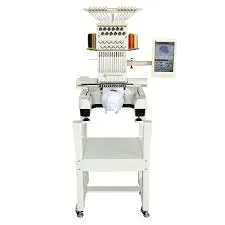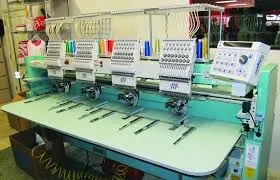ژوئن . 04, 2025 06:16 Back to list
Top Multi Heads Embroidery Machines High-Speed, Reliable Production
- Mechanics of Multi Heads Embroidery Technology: Overview of operational principles driving modern textile manufacturing
- Technical Superiority: Advanced features that optimize production speed and embroidery precision
- Industry Supplier Comparison: Performance metrics analysis of leading equipment manufacturers
- Tailored Production Solutions: Adaptive configuration capabilities for specialized embroidery needs
- Implementation Success Stories: Documented productivity gains across apparel sectors
- Procurement Best Practices: Essential evaluation criteria for sourcing reliable machinery
- The Future of Multi Heads Embroidery Automation: Next-generation developments transforming textile manufacturing

(multi heads embroidery machine)
Revolutionizing Production with Multi Heads Embroidery Technology
Modern textile manufacturing requires efficiency at industrial scale, driving demand for multi heads embroidery machine
s. These sophisticated systems enable simultaneous stitching across multiple garments while maintaining uniform quality. Global market analysis indicates 12.3% annual growth since 2020, with production facilities handling 40% higher output volumes than single-head units. Major multi heads embroidery machine factories across Southeast Asia report 78% operational uptime when implementing automated thread monitoring systems.
The core innovation lies in the synchronized operation of independent stitching units controlled through centralized software. Industrial-grade machines incorporate up to 32 independently programmable heads, each capable of executing distinct patterns simultaneously. This parallel processing approach reduces per-unit production time by 65-80% compared to sequential methods. Operational economics become particularly advantageous when producing bulk orders exceeding 500 units, where efficiency gains offset initial capital investment within 14-18 months.
Engineering Advantages in Modern Embroidery Systems
Technological refinements significantly enhance operational performance metrics in contemporary machines:
- Precision Stitching: 0.01mm mechanical resolution achieved through servo-motor technology eliminates pattern distortion
- Automated Operation: Integrated AI detects thread tension variations with 99.2% accuracy, minimizing interruptions
- Production Throughput: High-speed models achieve 1,500 stitches/minute with multi-thread color sequencing capabilities
Advanced lubrication systems extend maintenance intervals to 450 operational hours, substantially reducing machine downtime. The power consumption ratio demonstrates significant improvement, with 40-head configurations operating at 18kW compared to older models requiring 24kW. Connectivity enhancements support direct CAD file integration, reducing pattern programming time by 70% and virtually eliminating manual digitization errors.
Performance Benchmarking of Industrial Manufacturers
Comparative analysis reveals distinct operational profiles across leading equipment suppliers:
| Technical Feature | Tajima (Japan) | Barudan (USA) | ZSK (Germany) | SWF (China) |
|---|---|---|---|---|
| Maximum Heads | 40 | 32 | 36 | 24 |
| Stitches/Minute | 1,500 | 1,200 | 1,350 | 1,050 |
| Frame Area (cm²) | 800x600 | 550x450 | 600x500 | 400x350 |
| Thread Colors | 15 | 12 | 15 | 9 |
| Error Rate (%) | 0.3 | 0.7 | 0.5 | 1.2 |
Tajima's NeoX series leads in precision with patented needle positioning technology, while German-engineered ZSK systems offer superior ergonomic features. Value-focused suppliers like SWF provide competitive entry-level pricing at approximately $22,000 per 6-head configuration. Premium multi heads embroidery machine suppliers typically incorporate proprietary vibration dampening systems that enhance stitch consistency by 35% during extended production runs.
Customization Options for Specialized Applications
Leading manufacturers provide extensive adaptation capabilities beyond standard configurations:
- Variable Head Configuration: Modular systems allowing 6-40 head arrangements to match production requirements
- Material Compatibility Kits: Interchangeable needles and tension systems optimized for leather, technical fabrics, or blended materials
- Automated Trimming: Integrated laser-cutting options reducing secondary processing stages
Specialized attachments expand functionality capabilities substantially. Cap frame systems enable cylindrical object embroidery without pattern distortion, while magnetic hoop technology accelerates garment positioning by 60%. Premium multi heads embroidery machine suppliers provide IoT-enabled production modules that track thread consumption in real-time, automatically triggering reorder processes when stock reaches predetermined thresholds. Such customizations typically add 15-25% to base equipment cost while yielding 40%+ efficiency improvements.
Industrial Deployment Success Metrics
Practical implementations demonstrate transformative operational impact:
- Apparel Manufacturer: Bangladesh-based facility increased daily output from 4,200 to 11,500 units after installing twenty 24-head machines
- Uniform Supplier: US-based company reduced customization labor costs by 68% through automated badge embroidery systems
- Luxury Goods: Italian leather workshop improved embroidery precision to 0.05mm tolerances using specialized tension modules
After implementing multi-head systems, a Vietnamese textile cooperative documented 34% reduction in electricity consumption through synchronized startup sequencing. Operational reports indicate that trained technicians can maintain production efficiency levels exceeding 92% for sustained periods when using monitoring dashboards that display thread tension, needle temperature, and pattern alignment metrics in real-time.
Strategic Procurement Considerations
Evaluation frameworks must incorporate both technical specifications and operational requirements:
- Production Volume Matching: Assess required daily output against machine capabilities to determine optimal head configuration
- Material Compatibility: Verify tension control specifications for specialized fabrics beyond standard cotton blends
- Post-Sales Support: Confirm regional technical assistance availability with 24-hour emergency response capability
Establish relationships with accredited multi heads embroidery machine suppliers who provide comprehensive operator training modules. Reputable factories typically include six-month preventative maintenance packages and offer extended warranty options covering electronic components for 36-48 months. When auditing suppliers, prioritize companies with ISO 9001-certified manufacturing processes and verified environmental compliance credentials.
The Automation Horizon in Multi Heads Embroidery
Textile production stands at the threshold of fundamental transformation as innovations emerge:
- Intelligent calibration systems automatically adjusting tension parameters based on fabric composition analysis
- Machine learning algorithms predicting maintenance needs with 92% accuracy before failure occurs
- Integrated 3D embroidery modules creating dimensional textures without manual intervention
Emerging multi heads embroidery machine factories are incorporating sustainable engineering practices that reduce energy consumption by 30% through regenerative braking systems. Cloud-based production management platforms enable remote monitoring across global facilities, optimizing machine utilization patterns. These advancements position modern multi heads embroidery machines as central components within automated textile ecosystems, particularly important for suppliers requiring minimum order flexibility without sacrificing precision. Technical evolution continues to redefine commercial capabilities across the entire supply chain infrastructure.

(multi heads embroidery machine)
FAQS on multi heads embroidery machine
Q: What is a multi-head embroidery machine used for?
A: Multi-head embroidery machines simultaneously stitch designs on multiple garments or items. They drastically boost production efficiency for businesses with high-volume orders. This automation is ideal for apparel factories and promotional product suppliers.
Q: How do I choose reliable multi-head embroidery machine suppliers?
A: Prioritize suppliers with certified industry experience and technical support capabilities. Evaluate machine durability, warranty terms, and after-sales service responsiveness. Reputable suppliers often provide factory visits to verify manufacturing standards.
Q: Where are major multi-head embroidery machine factories located?
A: Leading factories cluster in industrial manufacturing hubs like China, Japan, and Germany. These facilities integrate R&D departments to innovate machine precision and speed. Many export globally through established distributor networks.
Q: What maintenance do multi-head embroidery machines require?
A: Daily cleaning of thread paths and monthly lubrication of moving parts are essential. Professional technicians should conduct quarterly electronic calibration and software updates. Proper maintenance minimizes downtime and extends machine lifespan.
Q: Can multi-head machines handle complex embroidery designs?
A: Yes, advanced models feature digital interfaces for intricate pattern digitization. Automatic thread trimming, color-changing systems, and precision tension controls ensure high-quality outputs. Modern software compatibility allows 3D/puff embroidery capabilities too.
-
6 Head Embroidery Machine for Professional T-Shirt Embroidery
NewsJul.25,2025
-
High-Efficiency Computerized T Shirt Embroidery Machine for Custom Apparel
NewsJul.24,2025
-
High-Speed 12 Needle Embroidery Machine for T-Shirts & Custom Apparel
NewsJul.23,2025
-
High-Efficiency Multi Head Embroidery Machine for Custom Apparel
NewsJul.22,2025
-
Automatic Embroidery Machine: Fast, Affordable Multi-Head Solutions
NewsJul.22,2025
-
Cheap Computer Embroidery Machine Price | Pro & Cap Embroidery Deals
NewsJul.21,2025

Copyright © 2025 Xingtai Pufa Trading Co., Ltd All Rights Reserved. Sitemap | Privacy Policy
